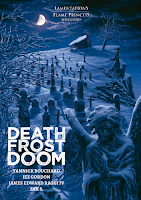 |
| Erol Otus is the best. |
What's strange is that I find stat blocks to be the easiest part of designing a creature. It's literally a handful of numbers. The difficult part is coming up with something that looks and behaves in a new and mysterious way. It's tough to come up with something the players haven't encountered before, yet sounds plausible, not something that feels like a bunch of monster parts Frankensteined together from random tables, like a dwarfs head with a unicorn horn, a Displacer Beast's tentacles, and the trunk of a Roper.
The main issue for him was being uncertain of whether he was creating something too hard or too easy, and he found the whole 5e challenge rating system confusing and difficult to wrap his head around. I asked him why worry about it. If you make it too tough, you're players can run away and figure out a way to defeat it tactically. If it's too easy, have two or three more come around the corner.
Challenge Ratings are something I don't really understand the need for in D&D. Perhaps it's just because I have enough confidence and experience to feel what the right difficulty is. I don't really need to think about it anymore (if I ever did), and I certainly don't need to consult a set of rules for encounter balance. And if the first-level players don't do enough information gathering, ignore the blatant warnings, and go traipsing into the temple of a slumbering chaos demon, well, they get what's coming to them.
Say you have a standard D&D adventuring party of a couple fighters, a cleric, a magic-user, and a thief - all around 4-6 level. How many ogres would you pit against them. If the setting and environment would support it, I would probably throw six at them. I would expect the party to (mostly) survive the encounter, but it might get a little hairy there depending on how the dice go. If the same PCs were 1-3 level I'd probably cut it down to two, maybe three. What's more important to me is picking a Number Appearing that makes sense for the environment that the players are exploring. In the above example, if six ogres would seem overcrowded in the area encountered, then I'd only have there be three, but just make them tougher.
That's just off the top of head. I'm sure someone would consult some official WotC oracle and tell me all the ways that encounter isn't balanced. Here's the thing: I don't care. If it proves too deadly, the worst that will happen is one of the players (or maybe more) will be making a new character. If you already have a predetermined outcome for the adventure, why play through it? Let things go wrong. That's part of the game. What do you think?




No comments:
Post a Comment